Coisas e Coisas
continued from July, 18
Pseudo-event
Ana Cabrera studied a solidarity action that took place in Portugal in 1992. This action was the initiative of Fórum Estudante magazine, represented by its director Rui Marques and it was called Missão Paz em Timor (Peace Mission in Timor), whose essential objective was to deposit a crown of flowers in Timor. It was a symbolic but risky action, for the eventual entry of the vessel in East-Timor would bring a lot of visibility to the question, which Indonesia would try to prevent.
The voyage to Timor was made on the Lusitânia Expresso (Cabrera, 2001:209) with 100 people on board, including students from Portugal and other countries, and journalists as well. A former president of the Republic, Ramalho Eanes, was among the entourage.
The mission took 62 days, from the first press conference of the project (16 January 1992) until the arrival of the participants (16 March 1992). The newspapers stress that, upon the arrival in Australia (Darwin), Indonesia threatens. There is a lot of emotion when it is known that an Australian television channel withdraws from the project for security reasons. Also, Indonesian students who are against the anti-democratic regime of Suharto do not enter the vessel. The biggest quality newspaper in Portugal, Público, writes in an editorial on 9 March 1992: "The adventure of the Lusitânia Expresso is a quixotic gesture which, such as all quixotic actions, is doomed to failure".
The final part of the voyage is prepared, the sea of Timor. On 10 March 1992 RTP, the Portuguese public television channel, broadcast 12 special information pieces through telephonic contact. Newspapers would choose the photograph of General Eanes, the person with the highest notoriety in the entourage. It is known then that two planes flew over the vessel and three Indonesian war ships approached it, trying to make the Portuguese vessel go back.
There was a great non-declared and non-achieved objective: the transmission of the event by CNN, which would be a guarantee of world visibility. Without the television, the event never took place.
Concept of pseudo-event
For Boorstin (1971), the explanation for the existence of pseudo-eventes lies in the journalists’ constant need for news. The organization of pseudo-events is shaped by the promoters to meets the interests of the media. They build the event and the communication strategy in terms of news-value (Cabrera, 2001:199). These pseudo-events, created and presented with naturalness, are taken very often as being spontaneous events.
Ana Cabrera called our attention as well to the famous events of Dayan and Katz (1992), that mobilise the media (Diana’s wedding, Diana’s funeral, Olympic Games, fall of the Berlin wall, the trips of pope John Paul II).
Agenda-setting in Lang and Lang
Rui Marques worked the East-Timor theme on the news based on the concept of agenda-setting in the Lang couple.
McCombs and Shaw had organised the concept of agenda-setting in 1972, when analysing the behaviour of voters in an American election. They reflected on the existence of three main agendas: public, political, media effect. Kurt and Gladys Lang (1981) criticised the linear model of the agenda-setting and concentrated in the agenda building process. Dividing the themes by levels (high and low), the media may have its greatest impact in the themes placed at a high level, with which the public have no direct contact (Marques, 2005:36). Without the media, the high level themes would probably not exist in public opinion.
The media do more than call people’s attention for a theme; they influence the way people think about it, namely through the interpretative context.
The Langs analyse, in the relational axis between news promoters, journalists and news consumers, four sequential and interactive phases that lead to the cycle of agenda-setting: 1st phase – focalization, 2nd phase – framing, 3rd phase – symbolic system, 4th phase – spokespeople.
East-Timor agenda-setting through the media
Rui Marques applied Langs’ theory for his analysis of the news (6635 news from the news agency Lusa, between 1987 and 1999). From the analysis, one can see that news grow exponentially from 1991, reaching its peak in 1999.
1. January 1987 to January 1989 – period of silence,
2. January 1989 to November 1991 – awakening period (John Paul II’s visit to Dili; massacre in the cemetery of Santa Cruz),
3. November 1991 to November 1994 – period of explosion (the vessel Lusitânia Expresso; imprisonment and judgement of Xanana; assault of the American embassy in Jakarta),
4. November 1994 to November 1997 – period of consolidation (attribution of the Nobel Peace Prize to D. Ximenes Belo and Ramos-Horta),
5. November 1997 to December 1999 – consecration period (fall of Suharto in Indonesia; signing of agreements in New York; referendum for self-determination in East-Timor).
Rui Marques worked categories applied to the news: a) Timor = victim; little David, b) Indonesia = oppressor; giant Goliath, c) bridges to the symbolic universe = Christianity, Portuguese language, peace, young students.
Using Langs’ model (focusing, framing, symbolic system, spokespeople), Rui Marques constructed it in this manner:
1. Focusing (pp. 91-118) – a) massacre in the cemetery of Santa Cruz (1991), Lusitânia Expresso vessel 1992); imprisonment and judgement of Xanana (1992-1993); assault of the American Embassy in Jakarta (1994), d) Nobel Peace prize (1996); e) referendum (1999),
2. Framing (pp. 118-132) – local and regional context in the 70s; revolutionary cause and ideological turnaround; changing world,
3. Symbolic universe (pp. 132-145) – as seen before: Christianity, the youth, Portuguese language, peace, victim (David against Goliath),
4. Spokepeople (pp. 145-150) – Xanana Gusmão, Ramos-Horta, Ximenes Belo.
Rui Marques writes that (2005:151), in any of the phases of the Langs’ model, the role of the journalists is essential. He thus concludes that the images of the massacre in Santa Cruz became a fundamental milestone in the scheduling process (2005: 177). The presence of journalists in Timor, on the other hand, opened a window to the world. The result of the referendum and the destruction brought about by the Indonesian people, as soon as the result became known, amplified the awareness of the world for the events in East-Timor. This time, CNN covered the event and the US helped in the process of self-determination.
In the interviews made by Rui Marques, I point out the one made to Xanana Gusmão. Mr. Gusmão considered the visit of pope John Paul II an important milestone.
Bibliography
Cabrera, Ana (2001). "Missão Paz em Timor: percurso de um pseudo-acontecimento". In Nelson Traquina, Ana Cabrera, Cristina Ponte e Rogério Santos O jornalismo português em análise de casos. Lisboa: Caminho
Marques, Rui (2005. Timor-Leste: o agendamento mediático. Porto: Porto Editora
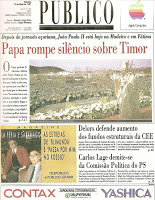

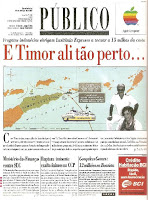
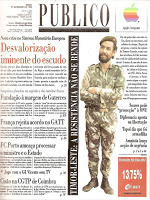

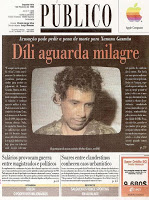
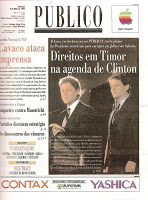
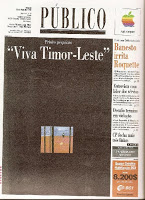
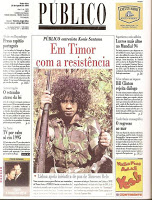
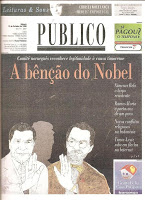
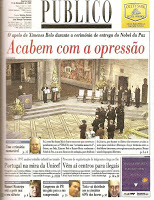
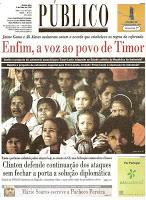


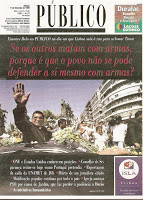
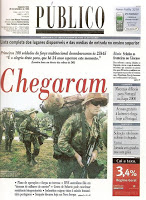


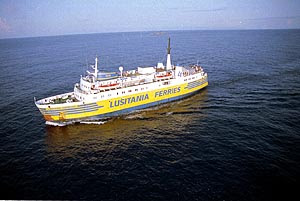
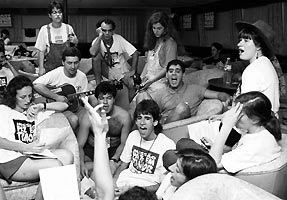
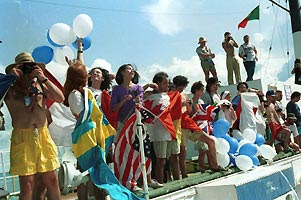
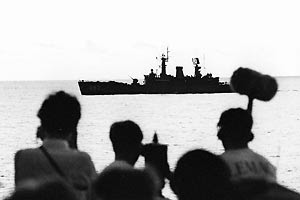
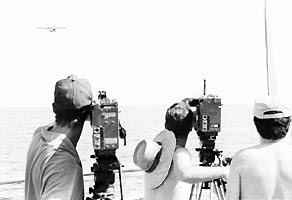
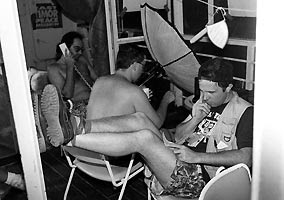

(newspaper images from Público, 300 Primeiras páginas; photos courtesy: Rui Marques)
- Iii Conference On Communication And Sports
http://comunicacaoedesporto.blogspot.pt/ Call for Papers 24 February 2014 Faculdade de Letras – University of Coimbra, Portugal Sports and media is a very important research field in the Portuguese Group for Communication, Journalism and Public Space,...
- News: Rewired
[from news: rewired] On 14 January 2010 we're holding news:rewired - a one-day event that will break away from journalism conferences asking the same old questions: where's the money, what's the point of social media, what's the future...
-
APRESENTAÇÃO PÚBLICA DO LIVRO DE RUI MARQUES Decorreu hoje ao fim da tarde, na Universidade Católica Portuguesa (UCP), o lançamento do livro de Rui Marques, actual Alto Comissário para a Imigração e Minorias Étnicas (ACIME), Timor-Leste: o agendamento...
-
LANÇAMENTO DE LIVROS (IV) Como se pode ler na coluna da direita, a 31 de Janeiro, pelas 18:00, na Universidade Católica Portuguesa, em Lisboa, Rui Marques vai lançar o seu livro Timor-Leste: o agendamento mediático, da Porto Editora. A presente obra...
-
DEFENDIDA TESE DE MESTRADO DE RUI MARQUES Saíu com a classificação de muito bom com distinção e louvor a tese defendida hoje de manhã na Universidade Católica Portuguesa, em Ciências da Comunicação, por Rui Marques. O tema da tese era A defesa...
Coisas e Coisas
EAST-TIMOR CAUSE, MEDIA, AND AGENDA-SETTING (II)
continued from July, 18
Pseudo-event
Ana Cabrera studied a solidarity action that took place in Portugal in 1992. This action was the initiative of Fórum Estudante magazine, represented by its director Rui Marques and it was called Missão Paz em Timor (Peace Mission in Timor), whose essential objective was to deposit a crown of flowers in Timor. It was a symbolic but risky action, for the eventual entry of the vessel in East-Timor would bring a lot of visibility to the question, which Indonesia would try to prevent.
The voyage to Timor was made on the Lusitânia Expresso (Cabrera, 2001:209) with 100 people on board, including students from Portugal and other countries, and journalists as well. A former president of the Republic, Ramalho Eanes, was among the entourage.
The mission took 62 days, from the first press conference of the project (16 January 1992) until the arrival of the participants (16 March 1992). The newspapers stress that, upon the arrival in Australia (Darwin), Indonesia threatens. There is a lot of emotion when it is known that an Australian television channel withdraws from the project for security reasons. Also, Indonesian students who are against the anti-democratic regime of Suharto do not enter the vessel. The biggest quality newspaper in Portugal, Público, writes in an editorial on 9 March 1992: "The adventure of the Lusitânia Expresso is a quixotic gesture which, such as all quixotic actions, is doomed to failure".
The final part of the voyage is prepared, the sea of Timor. On 10 March 1992 RTP, the Portuguese public television channel, broadcast 12 special information pieces through telephonic contact. Newspapers would choose the photograph of General Eanes, the person with the highest notoriety in the entourage. It is known then that two planes flew over the vessel and three Indonesian war ships approached it, trying to make the Portuguese vessel go back.
There was a great non-declared and non-achieved objective: the transmission of the event by CNN, which would be a guarantee of world visibility. Without the television, the event never took place.
Concept of pseudo-event
For Boorstin (1971), the explanation for the existence of pseudo-eventes lies in the journalists’ constant need for news. The organization of pseudo-events is shaped by the promoters to meets the interests of the media. They build the event and the communication strategy in terms of news-value (Cabrera, 2001:199). These pseudo-events, created and presented with naturalness, are taken very often as being spontaneous events.
Ana Cabrera called our attention as well to the famous events of Dayan and Katz (1992), that mobilise the media (Diana’s wedding, Diana’s funeral, Olympic Games, fall of the Berlin wall, the trips of pope John Paul II).
Agenda-setting in Lang and Lang
Rui Marques worked the East-Timor theme on the news based on the concept of agenda-setting in the Lang couple.
McCombs and Shaw had organised the concept of agenda-setting in 1972, when analysing the behaviour of voters in an American election. They reflected on the existence of three main agendas: public, political, media effect. Kurt and Gladys Lang (1981) criticised the linear model of the agenda-setting and concentrated in the agenda building process. Dividing the themes by levels (high and low), the media may have its greatest impact in the themes placed at a high level, with which the public have no direct contact (Marques, 2005:36). Without the media, the high level themes would probably not exist in public opinion.
The media do more than call people’s attention for a theme; they influence the way people think about it, namely through the interpretative context.
The Langs analyse, in the relational axis between news promoters, journalists and news consumers, four sequential and interactive phases that lead to the cycle of agenda-setting: 1st phase – focalization, 2nd phase – framing, 3rd phase – symbolic system, 4th phase – spokespeople.
East-Timor agenda-setting through the media
Rui Marques applied Langs’ theory for his analysis of the news (6635 news from the news agency Lusa, between 1987 and 1999). From the analysis, one can see that news grow exponentially from 1991, reaching its peak in 1999.
1. January 1987 to January 1989 – period of silence,
2. January 1989 to November 1991 – awakening period (John Paul II’s visit to Dili; massacre in the cemetery of Santa Cruz),
3. November 1991 to November 1994 – period of explosion (the vessel Lusitânia Expresso; imprisonment and judgement of Xanana; assault of the American embassy in Jakarta),
4. November 1994 to November 1997 – period of consolidation (attribution of the Nobel Peace Prize to D. Ximenes Belo and Ramos-Horta),
5. November 1997 to December 1999 – consecration period (fall of Suharto in Indonesia; signing of agreements in New York; referendum for self-determination in East-Timor).
Rui Marques worked categories applied to the news: a) Timor = victim; little David, b) Indonesia = oppressor; giant Goliath, c) bridges to the symbolic universe = Christianity, Portuguese language, peace, young students.
Using Langs’ model (focusing, framing, symbolic system, spokespeople), Rui Marques constructed it in this manner:
1. Focusing (pp. 91-118) – a) massacre in the cemetery of Santa Cruz (1991), Lusitânia Expresso vessel 1992); imprisonment and judgement of Xanana (1992-1993); assault of the American Embassy in Jakarta (1994), d) Nobel Peace prize (1996); e) referendum (1999),
2. Framing (pp. 118-132) – local and regional context in the 70s; revolutionary cause and ideological turnaround; changing world,
3. Symbolic universe (pp. 132-145) – as seen before: Christianity, the youth, Portuguese language, peace, victim (David against Goliath),
4. Spokepeople (pp. 145-150) – Xanana Gusmão, Ramos-Horta, Ximenes Belo.
Rui Marques writes that (2005:151), in any of the phases of the Langs’ model, the role of the journalists is essential. He thus concludes that the images of the massacre in Santa Cruz became a fundamental milestone in the scheduling process (2005: 177). The presence of journalists in Timor, on the other hand, opened a window to the world. The result of the referendum and the destruction brought about by the Indonesian people, as soon as the result became known, amplified the awareness of the world for the events in East-Timor. This time, CNN covered the event and the US helped in the process of self-determination.
In the interviews made by Rui Marques, I point out the one made to Xanana Gusmão. Mr. Gusmão considered the visit of pope John Paul II an important milestone.
Bibliography
Cabrera, Ana (2001). "Missão Paz em Timor: percurso de um pseudo-acontecimento". In Nelson Traquina, Ana Cabrera, Cristina Ponte e Rogério Santos O jornalismo português em análise de casos. Lisboa: Caminho
Marques, Rui (2005. Timor-Leste: o agendamento mediático. Porto: Porto Editora





















(newspaper images from Público, 300 Primeiras páginas; photos courtesy: Rui Marques)
loading...
- Iii Conference On Communication And Sports
http://comunicacaoedesporto.blogspot.pt/ Call for Papers 24 February 2014 Faculdade de Letras – University of Coimbra, Portugal Sports and media is a very important research field in the Portuguese Group for Communication, Journalism and Public Space,...
- News: Rewired
[from news: rewired] On 14 January 2010 we're holding news:rewired - a one-day event that will break away from journalism conferences asking the same old questions: where's the money, what's the point of social media, what's the future...
-
APRESENTAÇÃO PÚBLICA DO LIVRO DE RUI MARQUES Decorreu hoje ao fim da tarde, na Universidade Católica Portuguesa (UCP), o lançamento do livro de Rui Marques, actual Alto Comissário para a Imigração e Minorias Étnicas (ACIME), Timor-Leste: o agendamento...
-
LANÇAMENTO DE LIVROS (IV) Como se pode ler na coluna da direita, a 31 de Janeiro, pelas 18:00, na Universidade Católica Portuguesa, em Lisboa, Rui Marques vai lançar o seu livro Timor-Leste: o agendamento mediático, da Porto Editora. A presente obra...
-
DEFENDIDA TESE DE MESTRADO DE RUI MARQUES Saíu com a classificação de muito bom com distinção e louvor a tese defendida hoje de manhã na Universidade Católica Portuguesa, em Ciências da Comunicação, por Rui Marques. O tema da tese era A defesa...
